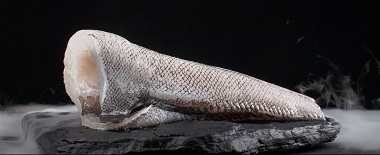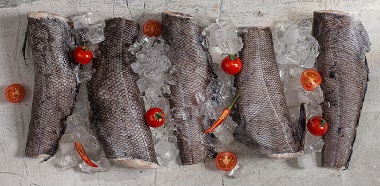 Prospects for deep-sea fish species are enormous. Depths of 1200-2500 meters are completely unexplored and in practice we have seen huge reserves of this specimen. Another important factor to consider is that the ecological environment at such depth is especially clean.
Prospects for deep-sea fish species are enormous. Depths of 1200-2500 meters are completely unexplored and in practice we have seen huge reserves of this specimen. Another important factor to consider is that the ecological environment at such depth is especially clean.
Grenadier, like pollock, is part of the cod family, but in contrast to offshore fish doesn’t have nematodes, which is an important factor to consider, and opens up an opportunity for consuming this specie in its raw form.
Grenadier’s biological quality and quantity of amino acids is significantly superior to any other type of fish.
Given its biological composition, it is believed that grenadier is an essential diet component for people with health problems. Eating a diet without fat is beneficial for people with heart conditions and other medical issues. Eating of grenadier is good for general maintenance of the body’s good state, providing the body with useful and necessary natural substances, for an excellent state of health, energy, and good disposition.
The method of consumption is also important. For maximum benefit for the body, unlike any other product, grenadier should be consumed in raw.
The most accurate measure of grenadier’s value is the price established by our customers. Since 2002, when grenadier fishery was started, the price has risen significantly and has already surpassed the price of pollock. Even though these two products are in the same cod family, grenadier price is accessible to people with average incomes.

We harvest grenadier exclusively with longlines to ensure we deliver the best possible quality product to our customers. The product quality of longline fishing is much better than the quality of trawled fish where raw material experiences tremendous pressure and thus naturally affects the quality of the final product.
Fishing stock of deep-sea fish can be described in two words – huge reserves, and the depths of 1200-2500 meters are virtually unexplored. Large reserves of raw material leads to simple fact that our medium-size longline vessels can effortlessly harvest 30-40 metric tons per day, whereas harvest of traditional species is approximately 4-6 metric tons per day.
Given the substantial margin of deep-sea fish and increased demand for this product, in the last years we expanded the longline fleet, retrofitting a few more vessels for deep-sea longline fishing.
Investments in the development and modernization of the longline fleet for the last 10 years have allowed our company to increase deep-sea fish harvesting for more than 3 times, up to 30 000 metric tons per year. The biggest part of this volume is grenadiers, accounting for more than half of the total catch of all vessels of the Far East basin.
Our customers have contributed in sustaining this very expensive deep-sea fishery by developing the market and advertising the market value of deep-sea product and gave us product price grown significantly.
This allowed us to continue these expensive operations. This couldn’t have happened without our customers who have come to value this deep-sea product.
We thank everyone who was involved in the development of these products for the Asian market.
Deep-sea fish species

Giant grenadier
Latin name: Albatrossia Pectoralis
Product description: Giant grenadier headed and gutted, tail off, block frozen.
Pacific grenadier
Latin name: Coryphaenoides Acrolepis
Product description: Pacific grenadier headed and gutted, tail off, block frozen.
Trade Offer
Our company annually produce up to 12 000 metrics tons of finished product of grenadier. In collaboration with the Pacific Research Institute of Fisheries, TINRO, we started researching these species. Biological reserves at depths of 1200 - 2500 meters are enormous.

Product supply for the customers is available year-round.
Grenadier is successfully fished thru out the year and product is available year-round. Grenadier has a wonderful appetite and often every hook on a longline will have a fish on. A standard longline contains 9000 hooks and each vessel is able to pull 2 to 3 long lines per day. This is adequate to fully load the freezing capacity of our longline vessels with production capacities of 30 tons per day.
Our Japanese built longline vessels are equipped with tuna-grade quick freezing refrigeration. Freezing cycles of up to minus 18 degrees Celsius takes 2 - 2.5 hours, which ensures excellent quality product. Cargo hold temperature is maintained at minus 60 degrees Celsius.
Given these two factors of freezing and storage of products, as well high levels of hygiene and sanitary control on the ships, our products are suitable for production of traditional Japanese dishes similar to sushi and sashimi.
There are several variations on a traditional dish of the northern nations of Europe and Russia called Stroganina (Siberian sashimi).
Product Quality
All products are produced in accordance with the requirements of the global market. All longline vessels are registered with the European Union Committee and have a unique identifier, which allows export of our products to Europe and the Asia-Pacific region. Crab products are processed onboard the crabber/processors and meet the sanitary requirements, norms, and regulations of Russia, USA, and Asia-Pacific countries.
Vostok-1 products are fully consistent with international standards. Buyers in these countries not only have a high culture of consumption, but also make high demands for the quality and environmental properties of the products.
Markets
Traditionally, Vostok-1 products are distributed to markets in Russia, Japan, USA, China, Korea and the EU.
